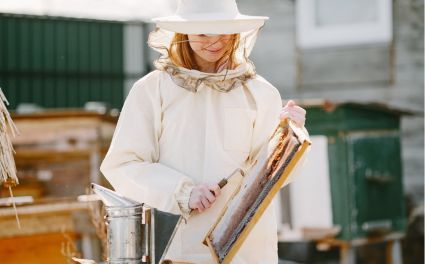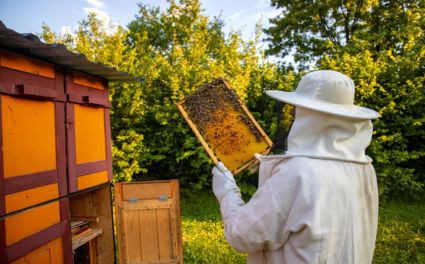Starting your beekeeping journey is exciting, but success begins long before you open your first hive. One of the most important steps in beekeeping is beehive setup. The way you place, position, and protect your hive has a direct impact on your colony’s health, honey production, and your own comfort as a beekeeper.
A poorly set up hive can lead to stressed bees, lower honey yields, and unnecessary risks during inspections. On the other hand, a well-planned beehive setup creates the perfect environment for your colony to thrive while making your work easier and safer.
Whether you’re a beginner or already have a few seasons under your belt, understanding the best practices for location, orientation, and shade will help you set your bees up for success.
Choosing the Right Location for Your Beehive
The first step in any successful beehive setup is selecting the right location. Bees are resilient creatures, but they’re also sensitive to their surroundings. A poorly chosen site can make the difference between a strong, productive hive and a weak, struggling one.
Here are a few important factors to consider:
-
Accessibility – Place your hive somewhere easy to reach for inspections, feeding, and honey harvesting. You’ll be visiting your hive regularly, so a difficult-to-reach spot will become a hassle quickly.
-
Neighbour and livestock safety – Keep hives away from high-traffic areas, pets, and livestock paddocks. Bees can become defensive when disturbed, so a quiet, low-traffic corner of your property is ideal.
-
Environment – Avoid spots prone to flooding or areas with constant foot traffic. A stable, well-drained patch of land will serve your hive best.
And don’t forget yourself in the process. When working around your hives, the right protective gear makes all the difference. Investing in durable beekeeping jackets and full beekeeping suits ensures you can carry out inspections and honey collection with both safety and comfort in mind.
Hive Orientation: Facing the Right Direction
When it comes to hive orientation, direction really does matter. Bees are most active when they catch the morning sun. That’s why experienced beekeepers often position hives to face east or southeast.
This orientation encourages the colony to start foraging earlier in the day, leading to stronger honey flows. It also helps bees warm up quickly during chilly mornings, which is especially important in cooler climates.
At the same time, it’s wise to shield your hive from strong winds. A natural windbreak—like a hedge, fence, or row of shrubs—can protect your hive without blocking sunlight.
When doing hive checks, protective essentials such as beekeeping gloves and beekeeping veils will keep you comfortable and safe, especially when bees are more active in warmer conditions.
Shade vs. Sunlight: Finding the Balance
One of the trickiest parts of beehive setup is finding the perfect balance between sun and shade. Too much shade can cause mould and dampness inside the hive, while too much sun can overheat the colony and stress the bees.
Here’s what works best for most beekeepers:
-
Morning sun – Encourages bees to start foraging early, boosting productivity.
-
Afternoon shade – Prevents overheating, particularly in hot Australian and New Zealand summers.
-
Filtered light – Trees or a shade cloth can help if natural shade isn’t available.
A hive that gets early sunlight and later relief from the heat is ideal. While your bees are kept comfortable, make sure you are too. Sturdy beekeeping trousers and breathable suits help you handle hive checks during hot days without sacrificing sting protection.

Ground Conditions and Hive Stability
Even the best-placed hive won’t thrive if the ground beneath it isn’t stable. Bees need a dry, secure foundation to stay healthy and productive.
-
Dry ground – Always choose well-drained soil to avoid moisture build-up. Damp conditions attract mould and pests.
-
Avoid low areas – Stay clear of flood-prone ground or dips where water collects after rain.
-
Hive stands – Use a sturdy stand to keep the hive off the ground. This improves airflow, helps prevent rot, and deters ants and small pests.
A stable hive also means combs are drawn evenly, making inspections and harvesting easier. If you’re keeping bees with children or in a family setting, protecting everyone with beekeeping kids suits is a must.
Accessibility and Safety for Beekeepers
Successful beekeeping isn’t just about the bees—it’s also about your safety and comfort. A proper beehive setup should take into account the beekeeper’s needs.
-
Space – Leave enough room around the hive for inspections, honey collection, and manoeuvring equipment.
-
Hive spacing – Avoid crowding hives together; give each colony its own space to prevent drifting and robbing.
-
Local regulations – Check your council’s rules for backyard beekeeping. Many areas require hives to be set back from property lines or shielded from neighbours.
-
Predator protection – Depending on your location, hives may need barriers against ants, wasps, or even larger animals.
When working around hives, small details matter. Protective gear like beekeeping ankle protection helps avoid painful stings around exposed areas, especially when inspecting lower brood boxes.
Common Mistakes to Avoid in Beehive Setup
Beekeepers—especially beginners—often make simple mistakes that can affect their colony’s success. Here are the most common ones to avoid:
-
Too much shade – Constantly shaded hives struggle with dampness and mould.
-
Too much sun – Full exposure to harsh sunlight can overheat bees.
-
Ignoring water sources – Bees need clean water nearby for cooling and feeding.
-
Overcrowding – Placing multiple hives too close together causes stress and increases robbing behaviour.
The good news is these mistakes are easy to avoid once you’re aware of them. To keep learning and improving your skills, you can read more blogs about beekeeping from experienced keepers.

Why the Right Gear Matters
Your bees need the right hive environment—but you also need the right equipment to manage them effectively. Protective clothing ensures you can work confidently and without stress.
At OZ Armour, you’ll find:
-
Breathable beekeeping suits for all-day comfort.
-
Lightweight beekeeping jackets for quick inspections.
-
Sting-proof beekeeping gloves and beekeeping veils.
-
Durable beekeeping trousers.
-
Beekeeping kids suits to keep young helpers safe.
-
Beekeeping ankle protection for sting-free feet and ankles.
This gear is designed by beekeepers, for beekeepers—making it a trusted choice worldwide.
Conclusion
A successful beehive setup is all about balance—choosing the right location, orienting the hive correctly, and managing sunlight and shade. By paying attention to these details, you’ll create the ideal conditions for a thriving colony.
Combine good hive placement with the right protective equipment, and you’ll enjoy a safer, more productive beekeeping journey. With the support of trusted brands like OZ Armour, you’ll have everything you need to manage your bees with confidence and care.












